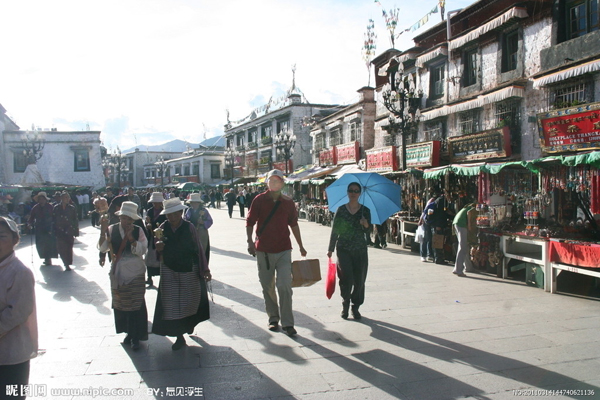
Lhasa's sunshine, mystique attracts diverse visitors. [Photo/ nipic]
Pilgrims, backpackers and tourists have swarmed the holy city of Lhasa despite the bitter winter and lack of oxygen, basking in sunshine and praying for good luck during the new year.
Pargor Street, which encircles the Jokhang Temple in the heart of Lhasa, is packed every day with pilgrims, who have hiked days or even months to the holy city, sightseers, who have chosen to tour Lhasa in the slack season, and metropolitan dwellers, who enjoy soaking up the ancient city's charm and ambiance.
Madlha Wagyalha prostrates himself in front of the Jokhang Temple, vowing his faith in Sakyamuni, the founder of Buddhism. ( The Tibetan taxi driver from the neighboring Qinghai Province has taken his wife and 5-year-old son to Lhasa to honor a commitment to Sakyamuni, which he made exactly a year ago.
The family left their home in Yushu, Qinghai in September and trekked four months to Lhasa. "Every night, we prostrated ourselves in Lhasa's direction before going to sleep in our tent," said Madlha Wagyalha.
For the devout Buddhist, the brutal cold and fatigue are nothing compared with the fulfillment of the pilgrimages to Jokhang and the Potala Palace, a lifelong dream for many Tibetans.
"Now at the Jokhang Temple, I feel I'm the happiest man on earth," he said.
The Jokhang Temple, which houses a life-sized statue of Buddha Sakyamuni as a 12-year-old, is the most renowned monastery in Lhasa.
DREAMS KEPT ALIVE
Two stylish young women sat crosslegged with solemn faces as they watched the Tibetans practice their observances.
"I feel calm and peaceful myself just to sit here in the sunshine and look at these devout Buddhists," said one of the women, who identified herself by her nickname "Dulupi."
Dulupi, from the southern Guangxi Zhuang autonomous region, never secured a job after she graduated from Beijing Institute of Fashion Technology in 2009. "I'd feel like a loser in a fast-paced city, but here in Lhasa I feel quite content."
For at least three weeks, she has enjoyed doing nothing but sitting in the sunshine and visiting Lhasa's tea houses with her new friend "Shadow" from Shanghai.
Unlike Dulupi, who plans to eventually return to a big city and become a fashion designer, Shadow is hoping to fulfil her dream in Lhasa.
Although trained as a chemist, Shadow said her dream to be a painter never died.
"I enjoy painting in the sunshine and tranquility in front of the Jokhang Temple," she said. "I've painted the devout Buddhists, young and old, and the red-and-white Tibetan style buildings."
Shadow hopes she can one day learn to paint thangkas, the traditional Tibetan scroll paintings, though she is not certain if any Tibetan artist would be willing to accept a Han woman as an apprentice.
VENDOR'S FOR LHASA
For nine years, Duan Xin has been selling porcelain ware at a stall on Pargor Street just a few paces from the Jokhang Temple.
His Tibetan-style tea sets and incense burners sell particularly well every year before and during the Tibetan New Year holiday.
This year, Tibetan New Year's Day falls on Feb. 22, about a month after the traditional Chinese Lunar New Year's Day.
Duan has ordered dainty tea sets whose cups and saucers are attached together by a magnetic ring. "It makes tea drinking and refilling it more convenient. The bright yellow color is also considered auspicious by Tibetans".
Duan, a native of Anhui Province in central China, came to Lhasa after he lost a factory job there. He has made many Tibetan friends and speaks fluent Tibetan.
Even his annual homecoming trip has never lasted for more than two weeks. "Very quickly, I miss Jokhang and Pargor and become eager to return to Lhasa."
